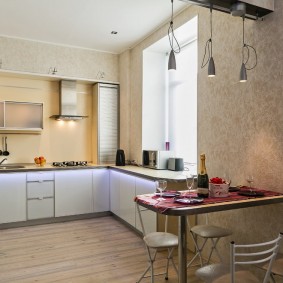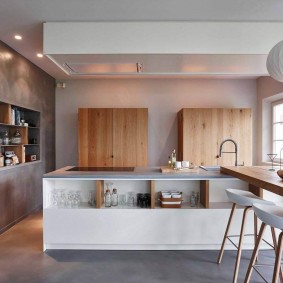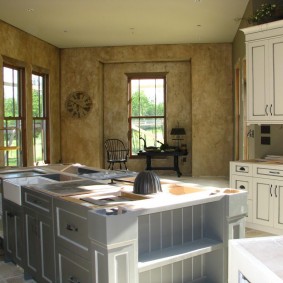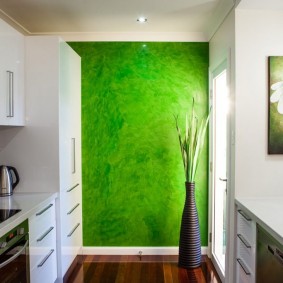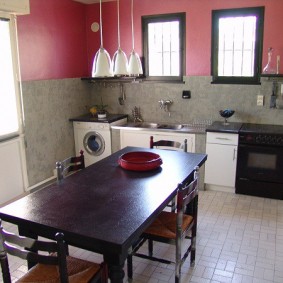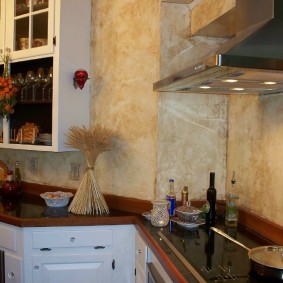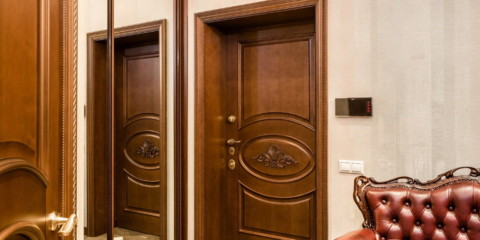 Interior
Wall decoration options with decorative decorative stone inside the apartment
Interior
Wall decoration options with decorative decorative stone inside the apartment
Wall decoration in the kitchen belongs to one of the crucial stages of arrangement. Many things are suitable for modern decoration: panels, wallpapers and other materials. But the greatest effect is created by decorative (Venetian) plaster. It harmoniously looks not only in the traditional interior, but also blends perfectly with modern style.

Decorative plaster in the kitchen is a modern solution in the repair.
Venetian stucco in the interior of the kitchen
Content
- Venetian stucco in the interior of the kitchen
- Advantages and disadvantages of using decorative plaster in a kitchen interior
- About the choice of decorative plaster
- Types of decorative plaster for the kitchen
- Combining venetian plaster with other materials in kitchen design
- Conclusion
- VIDEO: The process of applying decorative plaster.
- 50 kitchen design options with decorative plaster:
The characteristic features are a marble pattern. The play of light and the effect of overflow are achieved thanks to a special composition that includes binders, acrylic dyes, marble dust and other structures. Modern formulations may contain components such as sand, quartz, onyx and granite. The result is a thick paste with a consistency. This combination forms a durable, unusual and high-quality coating.
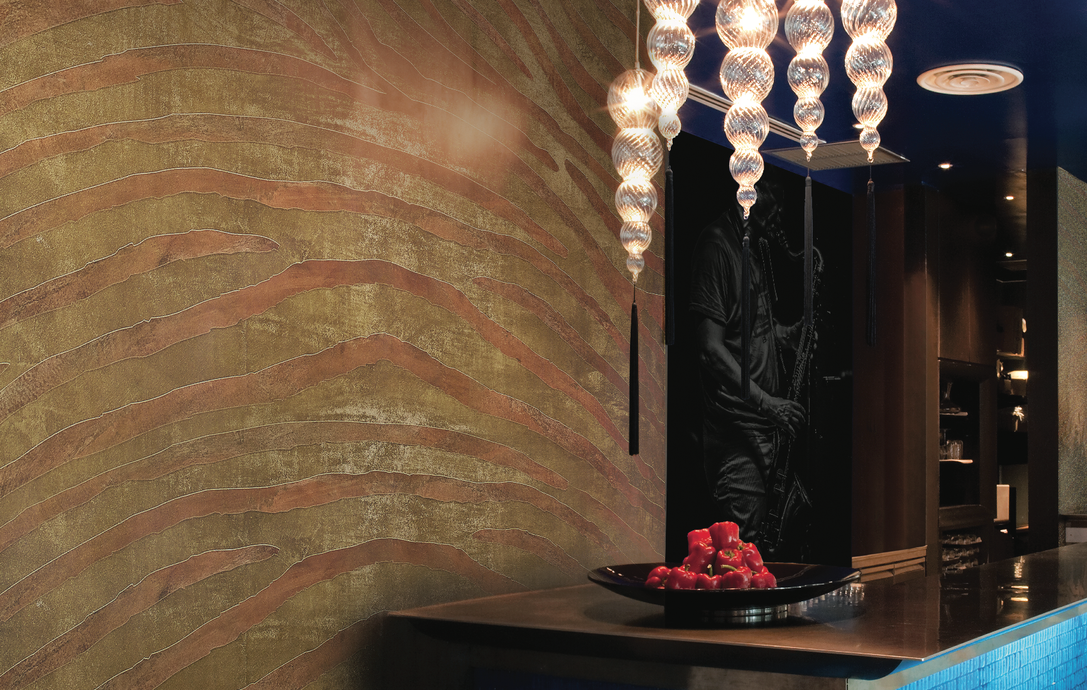
It is used for interior decoration and allows you to simulate various materials, while possessing high performance characteristics.
Beige, light brown and golden are traditional colors. Today, new technologies make it possible to achieve any shade. To obtain the desired color, it is tinted. The finished composition or dry mix goes on sale.
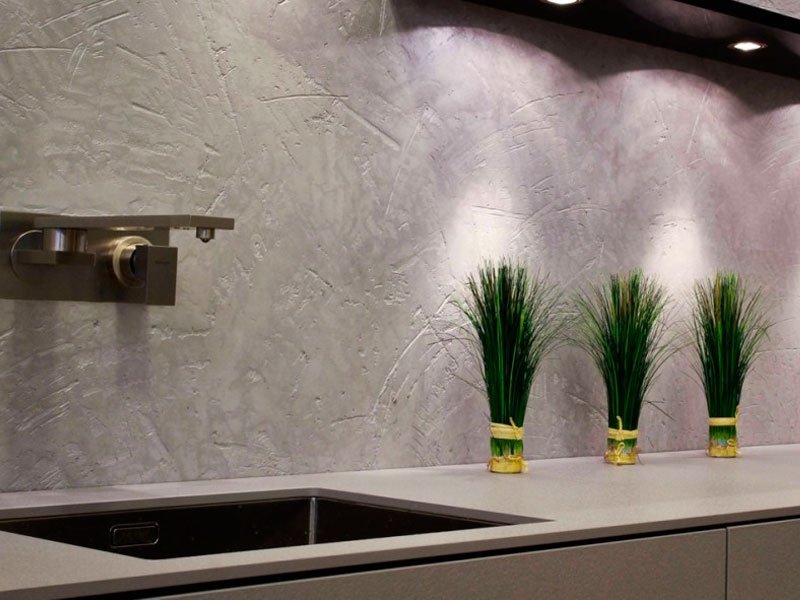
When choosing the option of decorating walls, an apron or a dining room area in the kitchen, practical, eco-friendly and aesthetic coatings must be preferred.
Important! To increase the life of the coating should be applied correctly, in compliance with the recommended process.
Advantages and disadvantages of using decorative plaster in a kitchen interior
The decorative composition can cover both individual parts of the kitchen room, and completely all the walls. The exception is the working area (apron). Venetian plaster in the kitchen perfectly divides it into functional areas: dining and working.

The composition includes natural materials and is suitable for use in the kitchen.
Key benefits include:
- imitation of natural structures thanks to a wide palette of colors;
- does not require preparatory work before coating;
- masking defects and roughnesses of walls;
- resistance to humidity, temperature differences, mechanical stress and the influence of aggressive cleaning agents;
- under all conditions, retains texture and primary color;
- durability (15-20 years);
- lack of joints and seamless coating (as a result, walls are less susceptible to abrasion);
- fire safety;
- does not absorb odors;
- universality (suitable not only for residential, but also for office premises);
- environmental friendliness;
- unpretentious care;
- natural components allow you to apply the mixture in child care facilities and hospitals;
- simple application technology.
Among the many advantages, there are also disadvantages:
- the material is not elastic, which increases the likelihood of cracks after drying;
- high price;
- difficult dismantling (difficult to remove from the walls);
- not compatible with a lot of decor.

Depending on the composition, decorative plasters may have certain performance characteristics and appearance.
Advice! To give the appearance of the walls a greater effect of marble, the plaster is applied in several shades (2-3).
About the choice of decorative plaster
The main difference between the decorative coating and the usual leveling composition lies in the presence of structure-forming components, plasticizers and binders of the polymer type. It is this composition that creates a pattern similar to marble. In this case, the patterns can be varied.

The mixture is based on mineral or synthetic material.
When choosing the right composition, you need to consider some nuances:
- matte or glossy surface;
- imitation of material (fabric, leather, quartz, marble, wood);
- color brightness depending on the style of the interior;
- incoming components;
- manufacturer (affects the quality of the plaster);
- price (it cannot be low).

Stone chips, cellulose fibers or polymer granules are used as additives to give surface relief.
For reference! Not suitable for outdoor decoration.
Types of decorative plaster for the kitchen
Depending on the type of bonding element, texture and external surface, several varieties of Venetian plaster are distinguished.

The kitchen uses Venetian, textured and structural plaster.
By type of basis
The difference is determined by the connecting elements:
- classical (consists of such components as marble chips, a binder and additives that give strength to the composition);
- mother-of-pearl (composition contains reflective particles that create optical effects);
- textured (special application technique allows you to imitate natural stone, wood and other materials);
- polymer (it is characterized by improved adhesion with the base, it fits well on concrete, drywall, primed metal, MDF, gypsum plaster is used as the basis);
- calcareous (lime-based mixture has better vapor permeability).
A composition based on cement and lime is called mineral. Silica mix contains quartz chips. The binder component is silicone or acrylic.
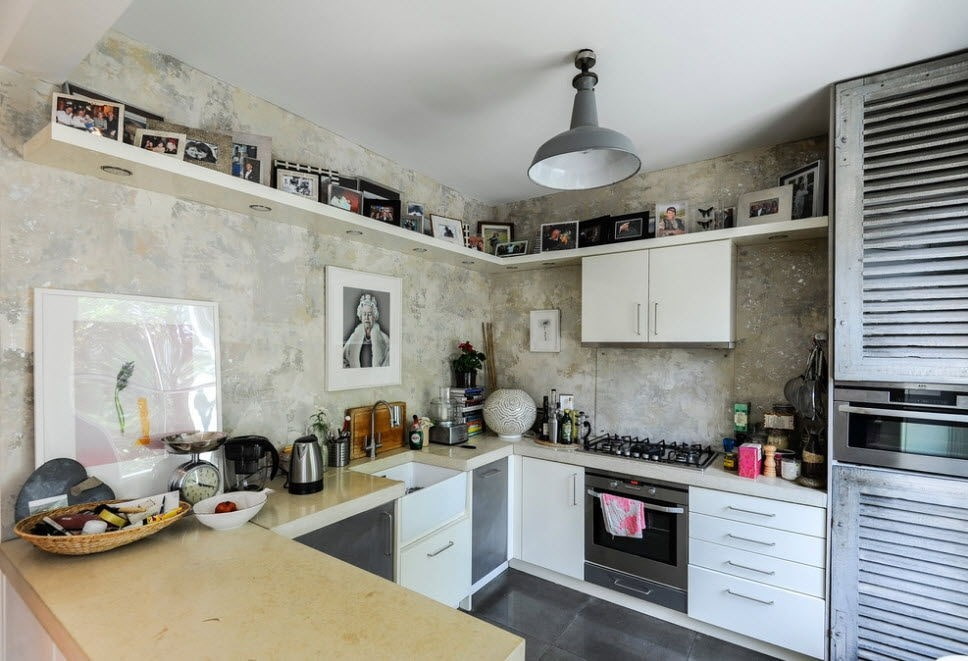
Finishing marble, made on the basis of plaster mixtures, is quite practical and economical compared to natural stone.
By design and application technique
One composition can recreate several different textures. One of them is a flat, classic surface. Relief plaster has a greater number of application techniques:
- craquelure (giving the surface artificial aging in the form of cracks by applying a special craquelure varnish);
- carrara (applied in several layers, each of which differs by half a ton from the previous one);
- veined coating (bituminous marble chips tinted with soot provides the effect);
- Trevignano (polymer mixture and special coating technique create the effect of a marble wall, imitating the illumination from the inside by the sun)
- encausto (recreation of a dull surface);
- Marbello (the surface resembles velvet with glossy veins);
- imperial (the golden pigment included in the composition shimmers in sunlight);
- wet silk (the effect of expensive fabric).

Venetian plaster consists of stone dust, a binder, a dye and allows you to play with color and relief.
For reference! Under the influence of weather conditions, the plaster may crack, while losing decorative and operational properties.
Stone decorative plaster
The decorative type of plaster easily replaces artificial and natural materials. For decoration, concrete, clay, gypsum, lime and other compounds are used. As a result, you can simulate malachite, granite, marble and other stones.

Cracking, or artificially aged coating with cracks, can be attributed to textured plaster.
There are several coating techniques.
- Flat. Smooth plaster recreates stones such as granite, marble, polished stone wall. A perfectly flat surface is covered with a composition of wax, and then polished.
- Textured. Appearance resembles a large solid stone with a rough surface.
- Flat-top. It is made in the form of masonry. Seams are indicated by a slight groove. Imitation of brick or stone blocks is possible. In this case, the surface of the wall is flat.
- Convex. Used molds that recreate the most realistic drawing.
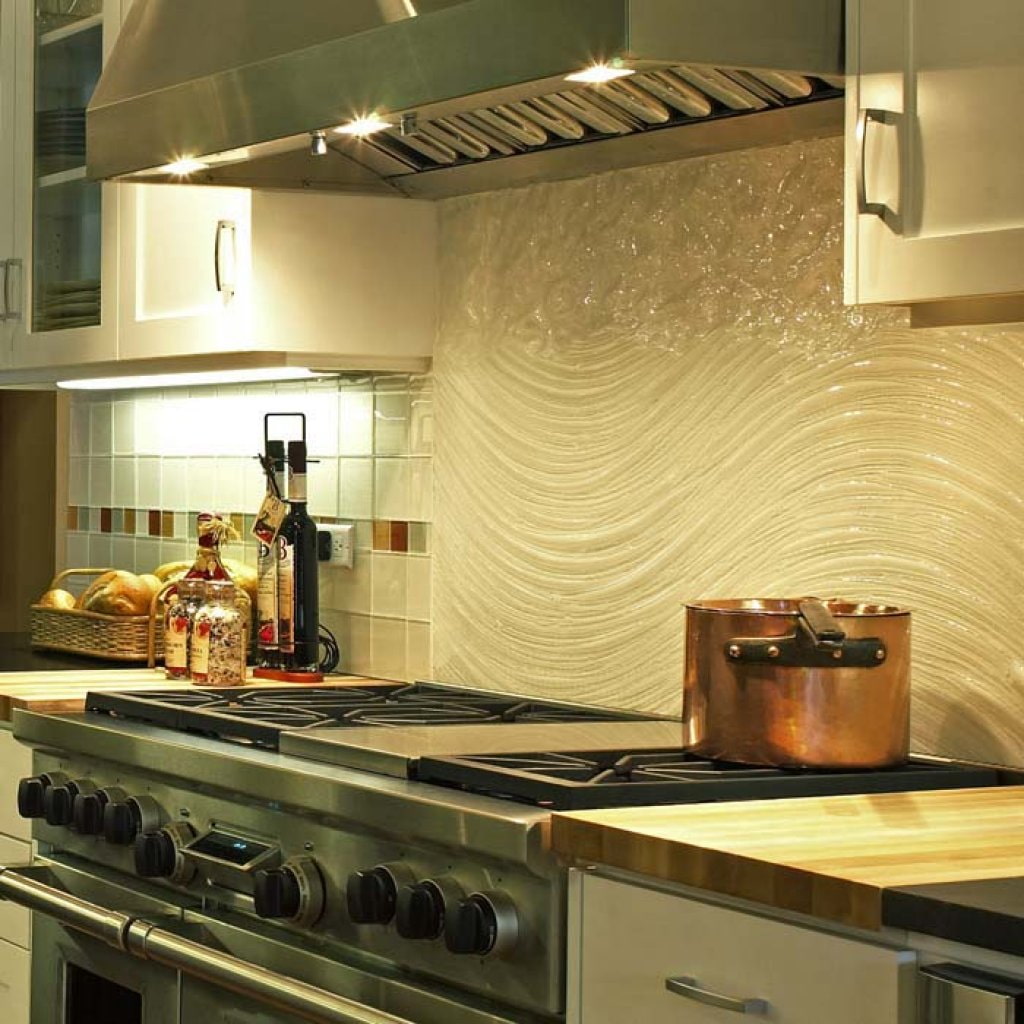
The combination of glossy and matte veins, as well as mother-of-pearl spraying creates the effect of a natural material.
Stone plaster works well with other building materials.

A decorative coating that has a granular structure due to the inclusion of insoluble granules or special fibers in the material is called structural.
Decorative plaster for concrete
The material is characterized by some features: it has a rough surface and a porous structure due to the content of sand and stone chips. To achieve relief, the plaster is applied in several layers.
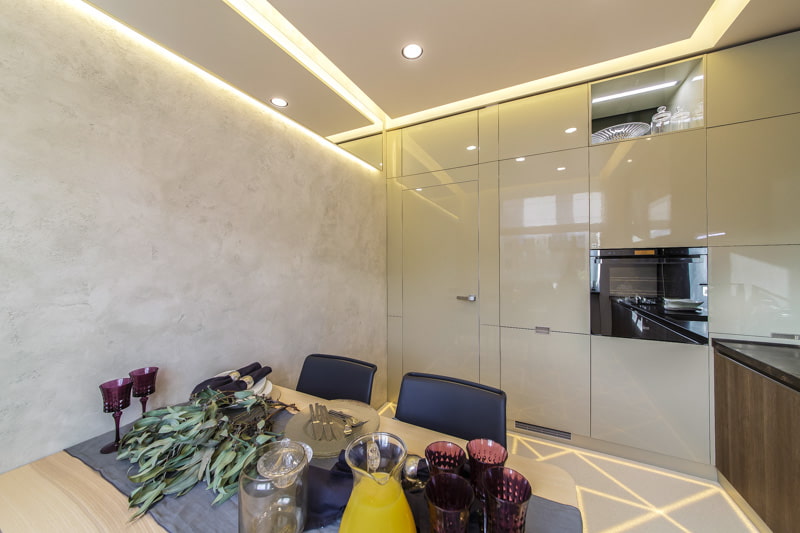
A decorative coating with the effect of concrete can be performed using special compositions, such as: microcement, decorative art concrete or ordinary cement mortar.
There are two main types.
- Microcement. The composition is a cement-polymer mixture without quartz chips. Suitable for finishing concrete, wood, metal, plastic surfaces and ceramic tiles.
- Micro concrete. The basis of the mixture is cement. Contains quartz chips, dyes and polymer additives. The composition does not absorb odors, is heat-resistant, and also has hygroscopicity and high ductility.

There is an extensive selection of gray, beige, white, sometimes rusty shades.
Decorative coating for concrete can be used in any interior. The material has good sound insulation and water resistance. Due to the low level of thermal conductivity, the energy efficiency of the room is increased. Types of decorative plaster and their compatibility in the kitchen can be seen in the photo.

Stucco with a glossy or metallic pigment creates the effect of wet silk in the interior of the kitchen.
Combining venetian plaster with other materials in kitchen design
After looking at the photos of modern Venetian plaster in the diverse interior of the kitchen, you can see that it harmoniously combines with other materials. The most common combination is with wallpaper. This combination requires the additional use of decorative trims and moldings. Their main goal is to smooth the transition between the two materials.
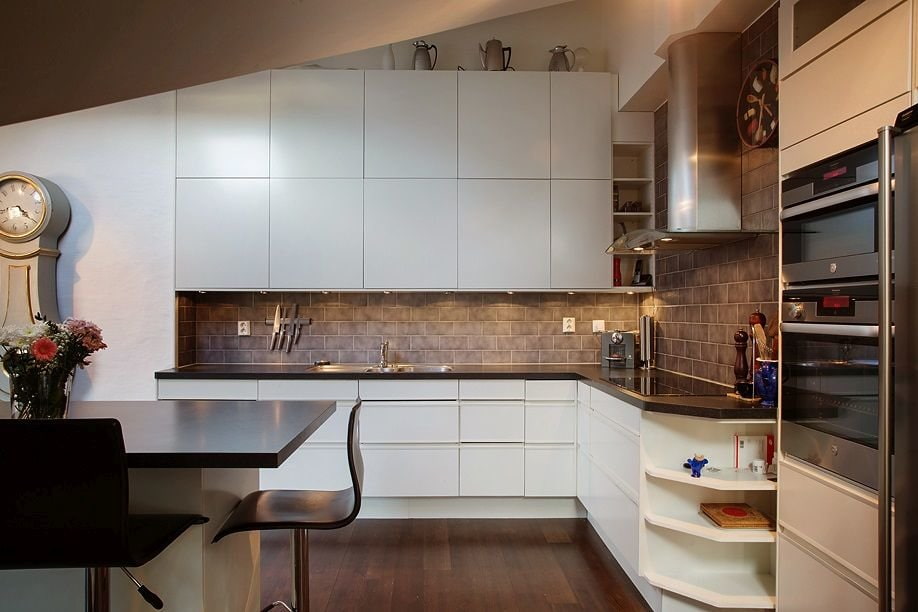
Plaster with coarse fractions and a mineral base allows volumetric finishing under a brick.
Quite often, a combination of plaster with a matte effect and a glossy plate is used. Looks good with a material with a natural stone. However, it is difficult to independently carry out such a finish. It is better to turn to professionals who not only perform quality work, but also advise other options for combining a Venetian stucco mixture.

Design using various shades will help to create the effect of scuffs on the wall or a two-color pattern.
Conclusion
Wall decoration in the kitchen with decorative plaster is aesthetically pleasing and attractive. The material, created on the basis of modified polymer resins, provides a beautiful and durable coating that mimics natural stone. The venetian marble finish is characterized by contrasting veins and a spectacular glossy surface.

Shades can be mixed or sprayed on each other, as well as combined with decorative painting.
VIDEO: The process of applying decorative plaster.



